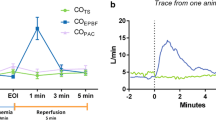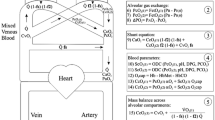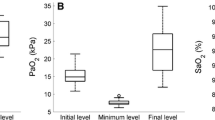Abstract
Objective. Inert gas rebreathing is a well established method for the non-invasive measurement of pulmonary blood flow. We tested the agreement in measurement of pulmonary blood flow (Qt rb) by a new inert soluble gas rebreathing device, the Innocor (Innovision, Copenhagen), with bolus thermodilution (Qt td) and the direct oxygen Fick (Qt Fick) method. Methods. 9 patients pre- and post-cardiac surgery were recruited resulting in 20 sets of measurements overall. Arterial and mixed venous blood samples were collected simultaneously with a thermodilution measurement and rebreathing manoeuvre to measure both V O2 and effective pulmonary capillary blood flow. Results. Mean bias (95% confidence limits) was: Qt rb − Qt td 0.01 (± 0.42) L/min; Qt rb − Qt Fick + 0.34 (± 0.59) L/min. The standard deviation of the difference between paired measurements was: Qt td − Qt rb ± 0.89 L/min; Qt Fick − Qt rb ± 1.26 L/min. Conclusions. Acceptable overall agreement between the Innocor and these reference standards was demonstrated.
Similar content being viewed by others
References
Krogh A, Lindhard J. Measurement of the blood flow through the lungs of man. Skand Arch Physiol 1912; 27: 125.
Cander L, Forster R. Determination of pulmonary parenchymal tissue volume and pulmonary capillary blood flow in man. J Appl Physiol 1959; 14(4): 541–551.
Ayotte B, Seymour J, McIlroy M. A new method for measurement of cardiac output with nitrous oxide. J Appl Physiol 1970; 28(6): 863–866.
Heneghan C, Branthwaite M. Non-invasive measurement of cardiac output during anaesthesia. Br J Anaesth 1981; 53: 351–354.
Petrini MF, Peterson BT, Hyde RW. Lung tissue volume and blood flow by rebreathing: Theory. J Appl Physiol 1978; 44(5): 795–802.
Hook C, Meyer M. Pulmonary blood flow, diffusing capacity and tissue volume by rebreathing: Theory. Respir Physiol 1982; 48: 255–279.
Christensen P, Clemensen P, Andersen PK, Henneberg SW. Thermodilution versus inert gas rebreathing for estimation of effective pulmonary blood flow. Crit Care Med 2000; 28(1): 51–56.
Clemensen P, Christensen P, Norsk P, Gronlund J. A modified photo- and magnetoacoustic multigas analyzer applied in gas exchange measurements. J Appl Physiol 1994; 76(6): 2832–2839.
Gabrielsen A, Videbaek R, Schou M, Damgaard M, Kastrup J, Norsk P. Non-invasive measurement of cardiac output in heart failure patients using a new foreign gas rebreathing technique. Clinical Science 2002; 102: 247–252.
Nunn JF. Applied Respiratory Physiology, 4th Edition, Butterworth-Heinemann, 1993, pp 196–197.
Kelman GR. Digital computer subroutine for the conversion of oxygen tension into saturation. J Appl Physiol 1966; 21(4): 1375–1376.
Kelman GR. Digital computer procedure for the conversion of PCO2 into blood CO2 content. Respir Physiol 1967; 3: 111–115.
Bland JM, Altman DG. Statistical methods for assessing agreement between two methods of clinical measurement. Lancet 1986; 307–310.
Akman G, Kaufman H, Roy R. Continuous Pulmonary Blood Flow Estimation from Measurements of Respiratory Anesthetic Gas Concentration. IEEE Trans Biomed Eng, BME 32 1985; 12: 1017–1031.
Durkin RJ, Evans TW, Winter SM. Noninvasive Estimation of Pulmonary Vascular Resistance by Stroke Index Measurement With an Inert Gas Rebreathing Technique. Chest. 1994; 106: 59–66.
Elkayam U, Wilson AF, Morrison J, Meltzer P, Davis J, Klosterman P, Louvier J, Henry WL. Non-invasive measurement of cardiac output by a single breath constant expiratory technique. Thorax 1984; 39: 107–113.
Espersen K, Jensen EW, Rosenborg D, Thomsen JK, Eliasen K, lsen NV, Kanstrup I-L. Comparison of cardiac output measurement techniques: Thermodilution, Doppler, CO2-rebreathing and direct Fick method. Acta Anaesthesiol Scand 1995; 39: 245–251.
Gan K, Nishi I, Chin I, Slutsky AS. On-Line Determination of Pulmonary Blood Flow Using Respiratory Inert Gas Analysis. IEEE Trans Biomed Eng. 40, 1993; 12: 1250–1259.
Pierce RJ, McDonald CF, Thuys CA, Rochford PD, Barter CE. Measurement of effective pulmonary blood flow by soluble gas uptake in patients with chronic airflow obstruction. Thorax 1987; 42: 604–614.
Haryadi DG, Orr JA, Kuck K, McJames S, Westenskow DR. Partial CO2 rebreathing indirect Fick technique for non-invasive measurement of cardiac output. J Clin Monit & Computing 2000; 16(5–6): 361–374.
Author information
Authors and Affiliations
Corresponding author
Rights and permissions
About this article
Cite this article
Peyton, P.J., Thompson, B. Agreement of an Inert Gas Rebreathing Device with Thermodilution and the Direct Oxygen Fick Method in Measurement of Pulmonary Blood Flow. J Clin Monit Comput 18, 373–378 (2004). https://doi.org/10.1007/s10877-005-1589-6
Received:
Revised:
Accepted:
Issue Date:
DOI: https://doi.org/10.1007/s10877-005-1589-6




